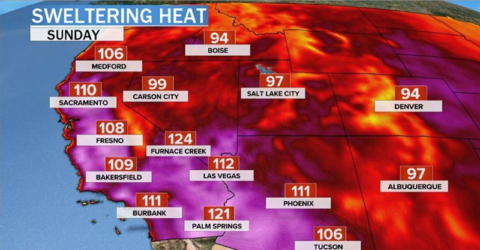In recent years, heat waves have broken long-standing records by large margins. In spring 2020, Siberia saw exceptional temperatures, and Europe experienced an extreme heat wave in 2003 that killed more than 70,000 people. Now a new study published in Nature Climate Change has found that the probability of extreme record-shattering events is increasing at an alarming rate. These events are unprecedented in the observational record and nearly impossible without climate change. The researchers warned that many places in the world have not yet seen anything close to the intensity of heat waves now possible but should expect them in the coming decades.
Sudden Record-Shattering Events
As the climate warms, you would expect heat waves to break previous records, but not necessarily by large margins. But when Erich Fischer at the Institute for Atmospheric and Climate Science at ETH Zürich in Switzerland and his colleagues looked at large climate model ensembles, they found that simulated events in the near future broke historic records by very large margins. Somewhat surprisingly, the simulations often did not show the intensity of heat waves steadily increasing. Instead, the simulations showed stagnant decades with unbroken or marginally broken records, followed by a sudden record-shattering event.

For example, a heat wave over central North America simulated by the models hit temperatures 18°C higher than the summer mean temperature for 1986–2005. The hottest week of the simulated event broke previous average weekly temperature highs in the simulation by more than 5 standard deviations, smashing records by massive margins. That simulated event is also remarkably similar to the extreme heat event in June that swept throughout the Pacific Northwest of the United States and Canada. During that heat wave, temperature anomalies were 16°C–20°C higher than normal maximum temperatures for the time of year, according to a new study produced by Sarah Kew and colleagues for the World Weather Attribution.
Kew, who is at the Royal Netherlands Meteorological Institute and was not involved in the research with Fischer and colleagues, said that the Nature Climate Change paper is very well timed given recent heat events (which occurred after the paper was written). She added that it is “really uncanny” how similar the simulated central North America event is to the Pacific Northwest heat wave. “[The authors] said that this kind of thing can happen in the near future; well, it just did happen. It acts as a very strong warning of what we can expect,” said Kew.
“The odds that a record-shattering heat event occurs somewhere in the northern extratropics is large and currently rapidly increasing.”
In high-emissions scenarios, weeklong heat extremes that break records by 3 or more standard deviations are 2–7 times and 3–21 times more probable in 2021–2050 and 2051–2080, respectively, compared with the past 3 decades, the researchers found. Their analysis suggested that an event as extreme as the one simulated over central North America is expected to occur once every 2 decades in the northern midlatitudes after 2050. Overall, record-shattering events—those that break records by 3 or more standard deviations—are expected to occur about every 6–37 years somewhere in the northern midlatitudes.
“Record-shattering heat extremes regularly occur in large ensemble simulations,” Fischer said. “While their probability is small for a specific location, the odds that an event occurs somewhere in the northern extratropics is large and currently rapidly increasing.” He warned that places that have not seen recent increases in heat wave intensity, such as the central and eastern United States, are particularly prone to such events and should expect to see new heat records in the coming decades. He argued that such events need to be taken seriously because their impacts tend to be largest when such temperature extremes first occur because of a lack of adaptation and preparedness.
“It is a clear message to cut emissions.”
The simulations showed that these record-shattering events are not caused by new climate mechanisms. Instead, there are extreme variations of common heat wave drivers in the months before, such as an unusually warm spring, low rainfall, low soil moisture, and reduced evaporative cooling. This scenario looks exactly like what led to the recent Pacific Northwest heat wave, according to Kew. She cautioned, however, that further investigation is needed before that can be said for certain.
What is more, Fischer told Eos that the probability of record-shattering heat events depends on the warming rate and not on the level of warming. “If we were to stabilize temperatures at 1.5°, 2°, or 2.5°C, their probability would quickly decline again after a few decades,” he explained.
“It is a clear message to cut emissions,” Kew said.
—Michael Allen ([email protected]), Science Writer
Citation:
Allen, M. (2021), Rapidly increasing chance of record-shattering heat extremes, Eos, 102, https://doi.org/10.1029/2021EO161527. Published on 03 August 2021.
Text © 2021. The authors. CC BY-NC-ND 3.0
Except where otherwise noted, images are subject to copyright. Any reuse without express permission from the copyright owner is prohibited.

